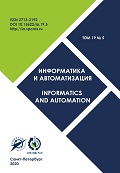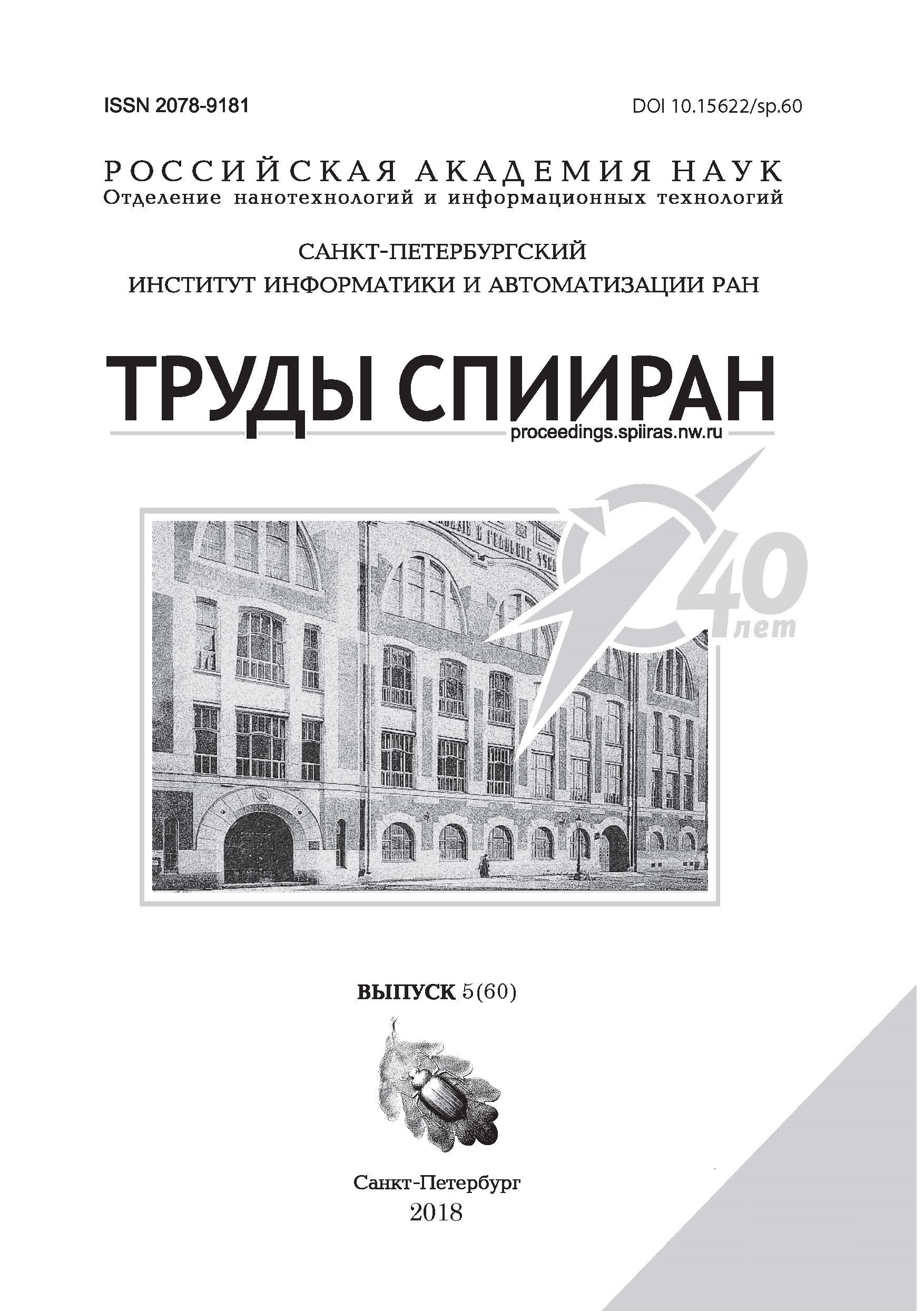Метод стилевых кодов для многостилевого параметрического синтеза речи по тексту
Ключевые слова:
синтез речи по тексту, экспрессивный синтез речи, глубокие нейронные сети, стиль речи, стилевой код, прямой унитарный векторАннотация
Современные системы преобразования текста в речь обычно обеспечивают хорошую разборчивость. Одним из главных недостатков этих систем является отсутствие выразительности по сравнению с естественной человеческой речью. Очень неприятно, когда автоматическая система передает утвердительные и отрицательные предложения совершенно одинаково. Введение параметрических методов в синтезе речи дало возможность легко изменять характеристики говорящего и стили речи. В этой статье представлен простой способ включения стилей в синтезированную речь, используя стилевые коды. Предлагаемый метод требует всего лишь пару минут заданного стиля, чтобы смоделировать нейтральную речь. Он успешно применяется как в скрытых марковских моделях, так и в синтезе на основе глубоких нейронных сетей, предоставляя стилевой код как дополнительный вклад в модель. Аудирование подтвердило, что наибольшая выразительность достигается за счет синтеза глубоких нейронных сетей по сравнению с синтезом скрытых марковских моделей. Также доказано, что качество речи, синтезированное глубокими нейронными сетями в определенном стиле, сопоставимо с речью, синтезированной в нейтральном стиле, хотя база данных нейтральной речи примерно в 10 раз больше. Глубокие нейронные сети на основе синтеза речи по тексту со стилевыми кодами изучаются путем сравнения качества речи, создаваемой системами одностилевого моделирования и многостилевого моделирования. Объективные и субъективные измерения подтвердили, что между этими двумя подходами нет существенной разницы.Литература
1. Hunt A.J., Black A.W. Unit selection in a concatenative speech synthesis system using a large speech database // Proceedings of International Conference on Acoustics, Speech, and Signal Processing (ICASSP-96). 1996. vol. 1. pp. 373–376.
2. Tokuda K. et al. Speech synthesis based on hidden Markov models // Proceedings of the IEEE. 2013. vol. 101. no. 5. pp. 1234–1252.
3. Watts O. et al. From HMMs to DNNs: where do the improvements come from? // International Conference on Acoustics, Speech and Signal Processing (ICASSP). 2016. pp. 5505–5509.
4. Ling Z.H. et al. Deep learning for acoustic modeling in parametric speech generation: A systematic review of existing techniques and future trends // IEEE Signal Processing Magazine. 2015. vol. 32. no. 3. pp. 35–52.
5. Yu D., Deng L. Deep learning: methods and applications // Foundations and Trends® in Signal Processing. 2014. vol. 7. no. 3-4. pp. 198–387.
6. Qian Y., Fan Y., Hu W., Soong F.K. On the Training Aspects of Deep Neural Network (DNN) for Parametric TTS Synthesis // International Conference on Acoustics, Speech and Signal Processing (ICASSP). 2014. pp. 3829–3833.
7. Delić T., Sečujski M. Sinteza govora na srpskom jeziku zasnovana na veštačkim neuralnim mrežama // Telecommunication forum (TELFOR 2016). 2016. pp. 403–406.
8. Solomennik A.I., Chistikov P.G. Evaluation of naturalness of synthesized speech with different prosodic models // Proceedeings International conference on Computational Linguistics and Intellectual Technologies “Dialogue 2013”. 2013. 7 p.
9. Abe M. Speaking Styles: Statistical Analysis and Synthesis by a Text-to-Speech System // Progress in speech synthesis. 1997. pp. 495–510.
10. Rusko M. et al. Expressive Speech Synthesis for Critical Situations // Computing and Informatics. 2015. vol. 33. no. 6. pp. 1312–1332.
11. Delić Т. et al. Multi- style Statistical Parametric TTS // Proceedings Digital speech and image processing (DOGS 2017). 2017. pp. 5–8.
12. Wu Z., Valentini-Botinhao C., Watts O., King S. Deep Neural Networks employing multi-task learning and stacked bottleneck features for speech synthesis // International Conference on Acoustics, Speech and Signal Processing (ICASSP). 2015. pp. 4460–4464.
13. Watts O. et al. From HMMs to DNNs: Where do the improvements come from? // International Conference on Acoustics, Speech and Signal Processing (ICASSP). 2016. pp. 5505–5509.
14. Delić T., Sečujski M., Suzić S. A review of Serbian parametric speech synthesis based on deep neural networks // Telfor Journal. 2017. vol. 9. no. 1. pp. 32–37.
15. Zen H., Tokuda K., Black A.W. Statistical parametric speech synthesis // Speech Communication. 2009. vol. 51. no. 11. pp. 1039–1064.
16. Zen H. et al. A hidden semi-Markov model-based speech synthesis system // IEICE transactions on information and systems. 2007. vol. 90. no. 5. pp. 825–834.
17. Yoshimura T. et al. Simultaneous modeling of spectrum, pitch and duration in HMM-based speech synthesis // Sixth European Conference on Speech Communication and Technology. 1999. 4 p.
18. Toda T., Tokuda K. A speech parameter generation algorithm considering global variance for HMM-based speech synthesis // IEICE transactions on information and systems. 2007. vol. E90-D. no. 5. pp. 816–824.
19. Tokuda K. et al. Speech Parameter Generation Algorithms for HMM-based Speech Synthesis // International Conference on Acoustics, Speech and Signal Processing (ICASSP). 2000. pp. 1315–1318.
20. Rabiner L.R. A tutorial on hidden Markov models and selectedapplications in speech recognition // Proceedings of the IEEE. 1989. vol. 77. no. 2. pp. 257–286.
21. Schröder M. Expressive speech synthesis: Past, present, and possible futures // Affective information processing. 2009. pp. 111–126.
22. Tao J., Kang Y., Li A. Prosody conversion from neutral speech to emotional speech // IEEE Transactions on Audio, Speech, and Language Processing. 2006. vol. 14. no. 4. pp. 1145–1153.
23. Iida A., Campbell N., Higuchi F., Yasumura M. A corpus-based speech synthesis system with emotion // Speech Communication. 2003. vol. 40. no. 1-2. pp. 161–187.
24. Yamagishi J., Onishi K., Masuko T., Kobayashi T. Modeling of various speaking styles and emotions for HMM-based speech synthesis // Eighth European Conference on Speech Communication and Technology. 2003. pp. 2461–2464.
25. Yamagishi J. et al. Model adaptation approach to speech synthesis with diverse voices and styles // International Conference on Acoustics, Speech and Signal Processing (ICASSP 2007). 2007. vol. 4. p. IV-1233–IV-1236.
26. Barra-Chicote R. et al. Analysis of statistical parametric and unit selection speech synthesis systems applied to emotional speech // Speech Communication. 2010. vol. 52. no. 5. pp. 394–404.
27. Inoue K. et al. An investigation to transplant emotional expressions in DNN-based TTS synthesis // Proc. APSIPA Annual Summit and Conference. 2017. pp. 1253–1258.
28. An S., Ling Z., Dai L. Emotional statistical parametric speech synthesis using LSTM-RNNs // Proc. APSIPA Annual Summit and Conference. 2017. pp. 1613–1616.
29. Lorenzo-Trueba J. et al. Investigating different representations for modeling and controlling multiple emotions in DNN-based speech synthesis // Speech Communication. 2018. vol. 99. pp. 135–143.
30. Stylianou Y., Cappe O., Moulines E. Statistical Methods for Voice Quality Transformation // Fourth European Conference on Speech Communication and Technology. 1995. pp. 447–450.
31. Hojo N., Ijima Y., Mizuno H. An Investigation of DNN-Based Speech Synthesis Using Speaker Codes // INTERSPEECH. 2016. pp. 2278–2282.
32. Fan Y., Qian Y., Soong F.K., He L. Multi-speaker modeling and speaker adaptation for DNN-based TTS synthesis // International Conference on Acoustics, Speech and Signal Processing (ICASSP). 2015. pp. 4475–4479.
33. Luong H.T., Takaki S., Henter G.E., Yamagishi J. Adapting and controlling DNN-based speech synthesis using input codes // International Conference on Acoustics, Speech and Signal Processing (ICASSP). 2017. pp. 4905–4909.
34. Yang S., Wu Z., Xie L. On the Training of DNN-based Average Voice Model for Speech Synthesis // Proc. Signal and Information Processing Association Annual Summit and Conference (APSIPA). 2016. pp. 1–6.
35. Wu Z., Watts O., King S. Merlin: An Open Source Neural Network Speech Synthesis System // Proc. 9th ISCA Speech Synthesis Workshop (SSW9). 2016. pp. 218–223.
36. Fan Y., Qian Y., Xie F.L., Soong F.K. TTS synthesis with bidirectional LSTM based recurrent neural networks // Fifteenth Annual Conference of the International Speech Communication Association INTERSPEECH. 2014. pp. 1964–1968.
37. Silverman K. et al. ToBI: A standard for labeling English prosody // Proceedings of International Conference on Spoken Language Processing (ICSLP). 1992. pp. 867–870.
38. Morise M., Yokomori F., Ozawa K. WORLD: a vocoder-based high-quality speech synthesis system for real-time applications // IEICE transactions on information and systems. 2016. vol. E99-D. no. 7. pp. 1877–1884.
39. Zen H. et al. The HMM-based speech synthesis system (HTS) version 2.0 // Proceedings of Sixth ISCA Workshop on Speech Synthesis. 2007. pp. 294–299.
2. Tokuda K. et al. Speech synthesis based on hidden Markov models // Proceedings of the IEEE. 2013. vol. 101. no. 5. pp. 1234–1252.
3. Watts O. et al. From HMMs to DNNs: where do the improvements come from? // International Conference on Acoustics, Speech and Signal Processing (ICASSP). 2016. pp. 5505–5509.
4. Ling Z.H. et al. Deep learning for acoustic modeling in parametric speech generation: A systematic review of existing techniques and future trends // IEEE Signal Processing Magazine. 2015. vol. 32. no. 3. pp. 35–52.
5. Yu D., Deng L. Deep learning: methods and applications // Foundations and Trends® in Signal Processing. 2014. vol. 7. no. 3-4. pp. 198–387.
6. Qian Y., Fan Y., Hu W., Soong F.K. On the Training Aspects of Deep Neural Network (DNN) for Parametric TTS Synthesis // International Conference on Acoustics, Speech and Signal Processing (ICASSP). 2014. pp. 3829–3833.
7. Delić T., Sečujski M. Sinteza govora na srpskom jeziku zasnovana na veštačkim neuralnim mrežama // Telecommunication forum (TELFOR 2016). 2016. pp. 403–406.
8. Solomennik A.I., Chistikov P.G. Evaluation of naturalness of synthesized speech with different prosodic models // Proceedeings International conference on Computational Linguistics and Intellectual Technologies “Dialogue 2013”. 2013. 7 p.
9. Abe M. Speaking Styles: Statistical Analysis and Synthesis by a Text-to-Speech System // Progress in speech synthesis. 1997. pp. 495–510.
10. Rusko M. et al. Expressive Speech Synthesis for Critical Situations // Computing and Informatics. 2015. vol. 33. no. 6. pp. 1312–1332.
11. Delić Т. et al. Multi- style Statistical Parametric TTS // Proceedings Digital speech and image processing (DOGS 2017). 2017. pp. 5–8.
12. Wu Z., Valentini-Botinhao C., Watts O., King S. Deep Neural Networks employing multi-task learning and stacked bottleneck features for speech synthesis // International Conference on Acoustics, Speech and Signal Processing (ICASSP). 2015. pp. 4460–4464.
13. Watts O. et al. From HMMs to DNNs: Where do the improvements come from? // International Conference on Acoustics, Speech and Signal Processing (ICASSP). 2016. pp. 5505–5509.
14. Delić T., Sečujski M., Suzić S. A review of Serbian parametric speech synthesis based on deep neural networks // Telfor Journal. 2017. vol. 9. no. 1. pp. 32–37.
15. Zen H., Tokuda K., Black A.W. Statistical parametric speech synthesis // Speech Communication. 2009. vol. 51. no. 11. pp. 1039–1064.
16. Zen H. et al. A hidden semi-Markov model-based speech synthesis system // IEICE transactions on information and systems. 2007. vol. 90. no. 5. pp. 825–834.
17. Yoshimura T. et al. Simultaneous modeling of spectrum, pitch and duration in HMM-based speech synthesis // Sixth European Conference on Speech Communication and Technology. 1999. 4 p.
18. Toda T., Tokuda K. A speech parameter generation algorithm considering global variance for HMM-based speech synthesis // IEICE transactions on information and systems. 2007. vol. E90-D. no. 5. pp. 816–824.
19. Tokuda K. et al. Speech Parameter Generation Algorithms for HMM-based Speech Synthesis // International Conference on Acoustics, Speech and Signal Processing (ICASSP). 2000. pp. 1315–1318.
20. Rabiner L.R. A tutorial on hidden Markov models and selectedapplications in speech recognition // Proceedings of the IEEE. 1989. vol. 77. no. 2. pp. 257–286.
21. Schröder M. Expressive speech synthesis: Past, present, and possible futures // Affective information processing. 2009. pp. 111–126.
22. Tao J., Kang Y., Li A. Prosody conversion from neutral speech to emotional speech // IEEE Transactions on Audio, Speech, and Language Processing. 2006. vol. 14. no. 4. pp. 1145–1153.
23. Iida A., Campbell N., Higuchi F., Yasumura M. A corpus-based speech synthesis system with emotion // Speech Communication. 2003. vol. 40. no. 1-2. pp. 161–187.
24. Yamagishi J., Onishi K., Masuko T., Kobayashi T. Modeling of various speaking styles and emotions for HMM-based speech synthesis // Eighth European Conference on Speech Communication and Technology. 2003. pp. 2461–2464.
25. Yamagishi J. et al. Model adaptation approach to speech synthesis with diverse voices and styles // International Conference on Acoustics, Speech and Signal Processing (ICASSP 2007). 2007. vol. 4. p. IV-1233–IV-1236.
26. Barra-Chicote R. et al. Analysis of statistical parametric and unit selection speech synthesis systems applied to emotional speech // Speech Communication. 2010. vol. 52. no. 5. pp. 394–404.
27. Inoue K. et al. An investigation to transplant emotional expressions in DNN-based TTS synthesis // Proc. APSIPA Annual Summit and Conference. 2017. pp. 1253–1258.
28. An S., Ling Z., Dai L. Emotional statistical parametric speech synthesis using LSTM-RNNs // Proc. APSIPA Annual Summit and Conference. 2017. pp. 1613–1616.
29. Lorenzo-Trueba J. et al. Investigating different representations for modeling and controlling multiple emotions in DNN-based speech synthesis // Speech Communication. 2018. vol. 99. pp. 135–143.
30. Stylianou Y., Cappe O., Moulines E. Statistical Methods for Voice Quality Transformation // Fourth European Conference on Speech Communication and Technology. 1995. pp. 447–450.
31. Hojo N., Ijima Y., Mizuno H. An Investigation of DNN-Based Speech Synthesis Using Speaker Codes // INTERSPEECH. 2016. pp. 2278–2282.
32. Fan Y., Qian Y., Soong F.K., He L. Multi-speaker modeling and speaker adaptation for DNN-based TTS synthesis // International Conference on Acoustics, Speech and Signal Processing (ICASSP). 2015. pp. 4475–4479.
33. Luong H.T., Takaki S., Henter G.E., Yamagishi J. Adapting and controlling DNN-based speech synthesis using input codes // International Conference on Acoustics, Speech and Signal Processing (ICASSP). 2017. pp. 4905–4909.
34. Yang S., Wu Z., Xie L. On the Training of DNN-based Average Voice Model for Speech Synthesis // Proc. Signal and Information Processing Association Annual Summit and Conference (APSIPA). 2016. pp. 1–6.
35. Wu Z., Watts O., King S. Merlin: An Open Source Neural Network Speech Synthesis System // Proc. 9th ISCA Speech Synthesis Workshop (SSW9). 2016. pp. 218–223.
36. Fan Y., Qian Y., Xie F.L., Soong F.K. TTS synthesis with bidirectional LSTM based recurrent neural networks // Fifteenth Annual Conference of the International Speech Communication Association INTERSPEECH. 2014. pp. 1964–1968.
37. Silverman K. et al. ToBI: A standard for labeling English prosody // Proceedings of International Conference on Spoken Language Processing (ICSLP). 1992. pp. 867–870.
38. Morise M., Yokomori F., Ozawa K. WORLD: a vocoder-based high-quality speech synthesis system for real-time applications // IEICE transactions on information and systems. 2016. vol. E99-D. no. 7. pp. 1877–1884.
39. Zen H. et al. The HMM-based speech synthesis system (HTS) version 2.0 // Proceedings of Sixth ISCA Workshop on Speech Synthesis. 2007. pp. 294–299.
Опубликован
2018-10-01
Как цитировать
Сузич, С., Делич, Т. В., Острогонац, С., Джурич, С., & Пекар, Д. Й. (2018). Метод стилевых кодов для многостилевого параметрического синтеза речи по тексту. Труды СПИИРАН, 5(60), 216-240. https://doi.org/10.15622/sp.60.8
Раздел
Искусственный интеллект, инженерия данных и знаний
Авторы, которые публикуются в данном журнале, соглашаются со следующими условиями:
Авторы сохраняют за собой авторские права на работу и передают журналу право первой публикации вместе с работой, одновременно лицензируя ее на условиях Creative Commons Attribution License, которая позволяет другим распространять данную работу с обязательным указанием авторства данной работы и ссылкой на оригинальную публикацию в этом журнале.
Авторы сохраняют право заключать отдельные, дополнительные контрактные соглашения на неэксклюзивное распространение версии работы, опубликованной этим журналом (например, разместить ее в университетском хранилище или опубликовать ее в книге), со ссылкой на оригинальную публикацию в этом журнале.
Авторам разрешается размещать их работу в сети Интернет (например, в университетском хранилище или на их персональном веб-сайте) до и во время процесса рассмотрения ее данным журналом, так как это может привести к продуктивному обсуждению, а также к большему количеству ссылок на данную опубликованную работу (Смотри The Effect of Open Access).







